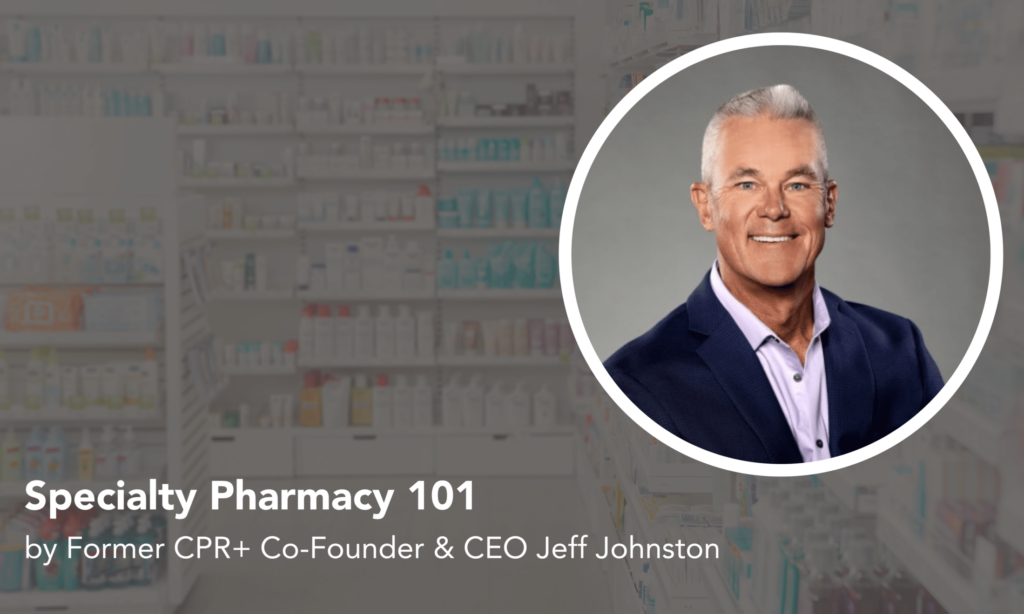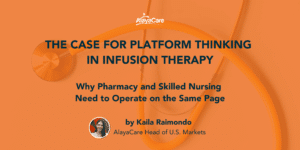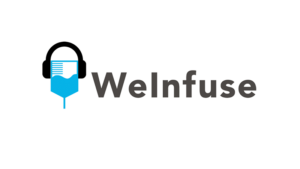Former CPR+ CEO & Co-Founder Jeff Johnston shares his knowledge regarding the specialty pharmacy space, and how companies can use this information to better operate and care for their patients. Jeff is also an Infusion Technology Advisory Council (ITAC) member and serves alongside other home infusion & specialty pharmacy professionals.
What is Specialty Pharmacy?
While similar in some respects to home infusion therapy, the term “specialty pharmacy” describes a very unique subcategory of pharmacy that focuses on dispensing “specialty medications” to patients who require them. These medications are classified as “specialty” due primarily to their cost, complexity, potential for side effects, and limited distribution. Specialty drugs frequently require intensive patient management (i.e. monitoring and dosing according to various lab results). While some specialty meds are taken orally, many are injected or infused. The site of service for specialty medications (i.e. where the drug is administered) depends on many factors, including physician preference, patient/family ability to safely self-administer, necessity of nursing personnel for injection/infusion/monitoring, and more.
The National Association of Specialty Pharmacy (NASP) defines specialty pharmacy as “a state-licensed pharmacy that solely or largely provides only medications for people with serious health conditions requiring complex therapies. These include conditions such as cancer, hepatitis C, rheumatoid arthritis, HIV/AIDS, multiple sclerosis, cystic fibrosis, organ transplantation, human growth hormone deficiencies, hemophilia, and other bleeding disorders. In addition to being state-licensed and regulated, specialty pharmacies should be accredited by independent third parties, such as the [Utilization Review Accreditation Commission] (URAC), the Accreditation Commission for Health Care (ACHC), the Center for Pharmacy Practice Accreditation, or the Joint Commission, in order to ensure consistent quality of care.”
Some specialty drugs are also known as “orphan drugs” because they are designed to treat diseases that afflict a relatively small number of people, generally less than 200,000 patients. The FDA definition of orphan drugs are medicines developed to help treat, prevent or diagnose rare “orphan” diseases, which are conditions that each affect fewer than 200,000 people in the U.S. Today, about 600 orphan drugs are approved by the U.S. Food and Drug Administration (FDA) to treat these difficult and rare diseases.
Pharmaceutical companies develop these orphan drugs knowing that the potential market for them is small, relative to drugs that treat more common conditions such as heart disease, high blood pressure, cancer, etc. Like many drugs, these medications take years to develop and bring to market. The FDA approval process is very intensive, and the percentage of drugs that ultimately receive approval and make it to market is quite low.
These factors all contribute to one of the primary characteristics of specialty drugs – they are very expensive. According to health insurer Wellmark, the average annual cost of a specialty drug is $84,000. Some are much more. In 2020, drug spend on specialty drugs exceeded 52% of overall prescription drug spending.
Pharma companies patent the drug formula for all new medications they are developing, preventing any other manufacturers from making the drug. Drug patents last for 20 years, however, as noted, the FDA approval process takes many years. The net effect is that once a drug receives FDA approval, it typically has approximately 10 years left on the patent. Once the patent expires, other companies can produce equivalents (e.g. generic or biosimilars) and the price generally falls.
According to the American Pharmacists Association (APA), specialty medications have the following characteristics:
- Treatment of complex, chronic, and/or rare conditions
- High cost, often exceeding $10,000, with some costing more than $100,000 annually
- Availability through exclusive, restricted, or limited distribution
- Special storage, handling, or administration requirements
- Ongoing monitoring for safety and/or efficacy
- Risk evaluation mitigation strategy
What are Specialty Pharmacies?
Specialty pharmacies are a subcategory of pharmacy operations that focus exclusively on the dispensing of specialty drugs. As with home infusion pharmacies, specialty pharmacies are licensed by the state as “closed door” pharmacies. They have no face-to-face interaction with the patient who has been prescribed the medication. Instead, these providers interact with the patient by phone to coordinate insurance coverage, co-pay, delivery, ongoing patient monitoring, and more.
The APA lists some of the services and key characteristics of a specialty pharmacy that go beyond the typical retail pharmacy, including:
- 24-hour access to pharmacists
- Adherence management – these are methodical efforts to assure the patient is taking the medication as prescribed
- Benefits investigation
- Communication and follow-up with the prescribing physician
- Dispensing of specialty medications and shipping coordination
- Enrollment in PAPs – patient assistance programs – which can help defray the cost of patient co-pays, etc.
- Financial assistance
- Patient education and medication adverse effect counseling
- Patient monitoring for safety and efficacy
- Payor and/or manufacturer reporting
- Proactive patient outreach for prescription refill and renewal
- Prior authorization assistance
These are some of the critical tasks that must be efficiently managed by any successful specialty pharmacy provider. Many are time dependent, labor intensive, and absolutely essential if the SP is to be profitable. As such, they will need and expect their software solution to provide robust functionality to address, automate, simplify and streamline these important tasks.
As noted, specialty medications are very expensive. I remember visiting a specialty customer in Tampa in 2005. They had been up and running for a year or so and had just moved into a new facility. The GM gave me the tour and he opened the door to a small room – maybe [10 feet by 15 feet] or so – with a retinal scan. It had a redundant power source, a separate HVAC system, and was tightly secured with the biometric locks which automatically logged the entry of each visitor. No, this was not the server room – it was where they stored their specialty drug inventory. As I recall, he told me it held over $40 million worth of inventory and it was only about half full!
While these medications boost revenue, the profit margin – the difference between what the pharmacy pays for the drug and what they are reimbursed by the payor for the drug – is often very small. This fact affects every operational decision the specialty pharmacy makes, including how and when they order, how much inventory they maintain, how and when they dispense the drugs to the patient, and more.
The thin margin also drives the SP’s need for volume. They often need a large number of patients on service to generate sufficient profits to run the business. Specialty pharmacy revenue is quite large, enormous even when compared to the typical HIT company, but it takes more patients to maintain profitability.
CPR+ sold our first specialty pharmacy customer in 2001. At the time, we weren’t completely sure what “specialty pharmacy” even meant. They told us they’d evaluated all of the retail pharmacy systems on the market, along with all of the other home infusion pharmacy systems, and none of them would work “as is”. They said they “hated CPR+ the least” and informed us that we’d have to build a significant amount of additional functionality to layer on to CPR+ for it to meet their needs. At the time, they were using a retail system to “fill and bill” and had cobbled together several other homegrown systems to manage their patients, collect necessary data, send, and receive countless faxes per day, attach them to the patient record, etc. They estimated they’d be billing around $1 million of revenue per DAY. At the time, our typical HIT customer did $3 million to $5 million in revenue per YEAR.
I thought there was no way we could handle a customer this large. I tried to politely tell them that we weren’t interested, but they would not take no for an answer. They became a client and with their significant input, we started building out the functionality they required. It was a huge challenge and did not always go perfectly but we learned a lot and they ran a huge SP operation on CPR+ for three to four years until they were acquired and transitioned to the new company’s proprietary software.
The experience taught us a great deal about how specialty pharmacies operated. They divided the workflow into critical steps and assigned staff to each step in the process. We mimicked their workflow by creating customized lists that streamlined and automated each step in the process. Once completed, each had a defined parameter that moved the patient / Rx to the next step in the process and into the next list. It was very automated and gave them real-time visibility into their workflow, allowing them to assess bottlenecks, backlogs, etc. The prescribed medication was not dispensed – which basically consisted of labeling the medication package and preparing it to be shipped (USPS, FedEx, UPS) – until the patient was contacted, insurance coverage was verified, and a successful test claim was processed to reflect adequate reimbursement. Most days, they received upwards of 100 new patient referrals. They came in via fax, either from a physician’s office, a hospital, or in some cases, from the payor.
Again, due to the cost of the medications, payors often established exclusive contractual relationships with one or more SPs, guaranteeing them referrals in exchange for the best possible price on the medications. The pharma companies would also establish exclusive or very limited distribution agreements with wholesalers and pharmacies. In exchange for granting the SP access to buy the medications, the SP agreed to stringent performance metrics designed to assure the patients received their medications, took them as prescribed, and received all possible refills and Rx renewals. The SPs were also required to collect volumes of patient data and deliver it back to the pharma company. In order to comply with these contractual obligations, the SP relied on their software to manage the business to collect and organize the required data.
Specialty Pharmacy vs Home Infusion Pharmacy:
While both types of businesses dispense injectible or infusible medications to patients for administration in the home or physician office, there are also differences between a traditional home infusion pharmacy and a specialty pharmacy.
Service Area:
Home infusion companies deliver medications to patients within a defined service area. Nurses and delivery personnel from the HIT company interact with the patient directly by teaching or administering the medication, monitoring, maintaining IV access, etc.
Often, SPs have a broad service area and may ship medication to patients all over the country. Specialty pharmacy providers talk to the patient on the phone, send printed teaching material and patient instructions, and in some cases, work with local nurses.
Referrals:
Home infusion providers generally get referrals from hospitals and physicians within their service area. Payor agreements also generate some referrals through contractual relationships with providers.
Specialty pharmacy referrals are typically generated by a physician managing a chronic condition for their patient. Referrals may also be driven by payors and manufacturers through limited or exclusive provider and distribution agreements.
Payment for drugs / services:
Home infusion services are typically reimbursed by commercial insurance, and often HIT claims process through the medical benefit. Patients may also access coverage for HIT through the pharmacy benefit.
Specialty providers bill the patient’s primary and secondary insurance. However, there are many additional funding sources for specialty drugs. Specialty pharmacies and patients work closely with patient advocacy groups, and there are many foundations and grants available to patients based on their disease state and financial need. Manufacturers also have financial assistance for some drugs in the form of copay assistance programs which can significantly reduce the financial liability of the patient.
Labor:
Home infusion drugs typically require more preparation prior to dispensing to the patient. They are usually mixed (compounded) in a clean room, and once prepared, have a limited stability or shelf life (e.g. 1 week). The maintenance and upkeep of the clean room is extensive, and the process to make the end product takes time and precision by the pharmacist or technician. These medications often require monitoring of lab results and can only be prepared once lab results have been analyzed. Many times an intervention is performed by a pharmacist that requires a dose or medication change to increase effectiveness of the treatment or reverse reactions to therapy. Patients or family members often learn to administer these medications but in some cases, depending on many factors, administration by a nurse in the home is required, adding to the cost and complexity of therapy.
Specialty medications are not mixed by the pharmacy and most specialty pharmacies do not have a clean room. The medications are shipped to the patient in the original unopened box that came from the pharmaceutical company. These medications are withdrawn from the packaging just prior to administration, dramatically extending their stability and shelf life. Routes of administration are typically by injection, infusion, or oral solution and may not require nursing services. Specialty medications are generally shipped to the patient once a month, which decreases staff time needed to contact patients, collect medication therapy management data, and prepare shipments. While requiring less labor per Rx, specialty pharmacies usually manage a much higher volume of prescriptions and a larger number of patients than the average home infusion company.
In conclusion, the specialty pharmacy industry provides patients suffering from rare, complex, and chronic diseases with life-changing medications. Compared to traditional home infusion therapy, specialty pharmacies are often higher volume businesses.
Of course, patients are the primary concern, but each prescription is still treated as a unique entity and managed through the workflow. Insurance eligibility and payor reimbursement must be verified before every fill, and interaction with the patient / family is generally limited to phone calls. The software requirements to run a specialty pharmacy business are also different as systems must simultaneously handle the significant volume and pace of prescriptions being ordered, while also facilitating the complex workflow, delivery management, data capture, and reporting that is required.
About WeInfuse
WeInfuse is the premier technology and consulting provider for infusion therapy and medication delivery in the U.S. The WeInfuse software platform powers over 700 infusion centers across the country. Backed by decades of experience, WeInfuse consulting services guide clients through the dynamic infusion landscape.
WeInfuse has expanded its software platform to include a complete home infusion and specialty pharmacy workflow. WeInfuse software helps organizations operate efficiently, maximize profitability, decrease burnout, and improve clinical outcomes. Its powerful, intuitive features for infusion workflows and robust reporting & analytics engine help take the confusion out of infusion. To learn more, email marketing@weinfuse.com or visit www.weinfuse.com.
Guest Author: With many years of home infusion software experience, Former CPR+ Co-Founder and CEO, Jeff Johnston, now serves as the WeInfuse Advisor on the Infusion Technology Advisory Council (ITAC) and guides our team to further advance our HIT platform solution.





